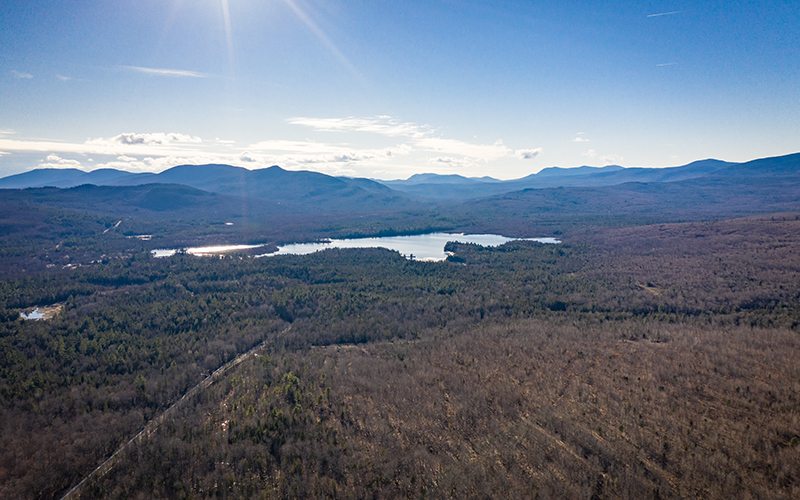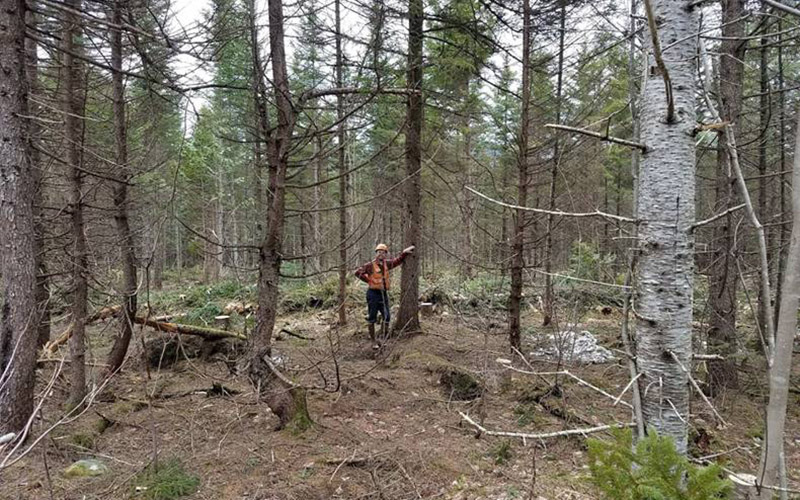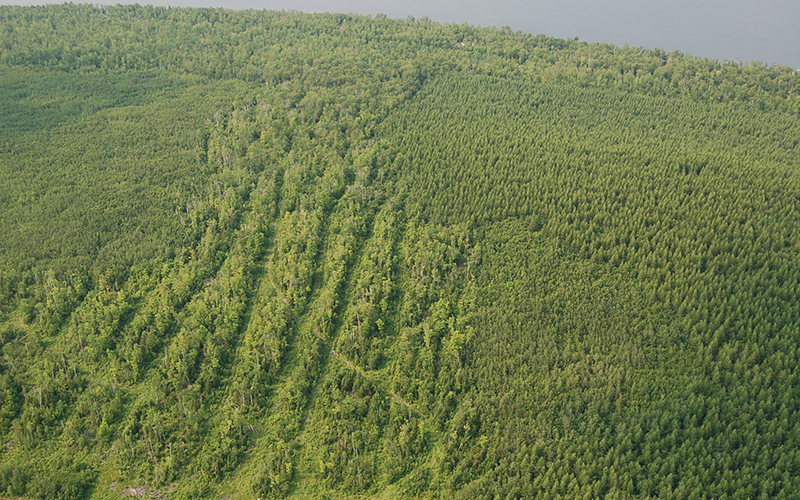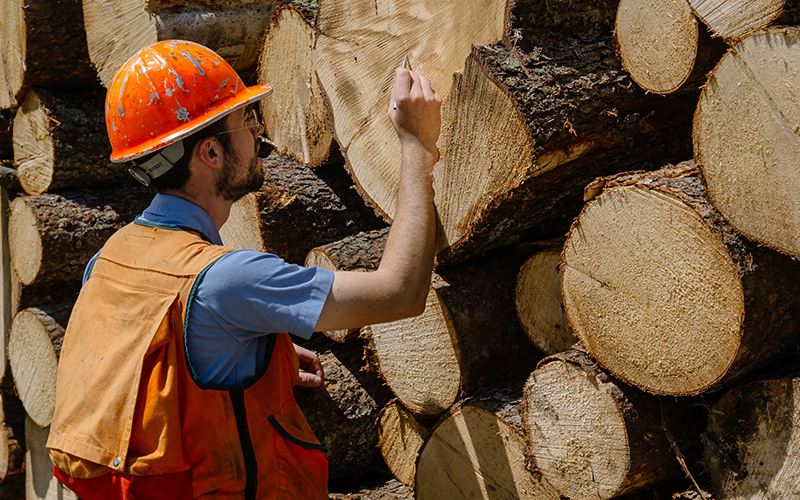What Responsible Forestry Means at AMC

AMC purchased its first parcel of land in Maine’s 100-mile Wilderness in 2003. Today, AMC owns nearly 75,000 acres of land in the Maine Woods, achieving landscape-scale conservation goals, creating a new outdoor recreation destination, partnering with local communities on economic development and environmental education, and inventing a new model for land ownership that is self-sustaining. A perhaps less-known pillar of AMC’s Maine Woods Initiative is its commitment to responsible forestry and timber management on certain parcels of land it owns and manages.
Since 2004, AMC has been practicing responsible forestry on the core of its Maine Woods Initiative (MWI) property. The work has been focused on restoring the forest to a more natural condition and cementing AMC’s role as a long-term owner. In 2019, AMC took charge of the nearly 27,000-acre Pleasant River Headwaters Forest, which AMC manages and is in the process of purchasing. AMC plans to reinvest returns on timber, which is certified by the Forest Stewardship Council®, back into the 100-Mile Wilderness while also creating logging jobs vital to Maine’s rural economy. The land’s current owner—the Conservation Fund—allows AMC to manage the forest, which has been continuously harvested for timber since the mid-19th century, in advance of the land transfer and to apply any profits toward the eventual purchase. Forestry will account for a small percentage of the $25 million needed to finalize the deal, with the rest raised from donors.

Why Forestry?
Why does a nonprofit dedicated to protecting and enjoying the mountains, forests, waters, and trails in the Northeast and Mid-Atlantic regions practice forestry? The wood products industry is a core foundation of the local economies in Maine, and we don’t anticipate this changing. AMC is committed to partnering in the local economy through responsible forestry, even as it expands wilderness-based recreation in the area. Economic development need not pit backcountry recreation against timber management. One of the core goals of the MWI mission is the ecological restoration of previously industrial forests used to feed paper mills. Responsible harvesting is a critical tool to return these forests to their full ecological functionality.

What is Responsible Forestry?
Responsible forestry, as defined by the Forest Stewardship Council®, is committed to the following: conserving vulnerable habitats; minimizing erosion from roads; protecting rivers and streams; protecting at-risk species; preventing overlogging; and protecting community rights, including indigenous communities. AMC’s holistic land management philosophy prioritizes the ecological and public benefits of forests as foundational for the well-being of both the natural and built environment. This recognition of the interconnected dependency of forests and people lies at the core of socially responsible forestry. AMC has been Forest Stewardship Council® FSC®-C008922 certified since 2015.

Responsible Forestry at AMC
The overall objective of forestry at AMC is ecological and economic sustainability. Achieving this objective will be a long-term process, extending dozens and even hundreds of years. This process, known as late-successional management, integrates two main objectives in its goal to restore forests to a more natural state:
- Develop mature, multi-aged, high-value forest stands: The goal here is to increase the number of large-diameter old trees that exist on the land and give these trees a chance to life a full life and die naturally. This increases both the ecological and economic value of the forest and greatly increases its ability to sequester carbon.
- Increase the average diversity of managed stands: AMC aims to grow a more ecologically diverse forest. In the face of climate change, promoting natural species diversity over industrial monocultures will be crucial as the Northeast adapts to landscape-scale shifts in species composition.

Traditional Forestry vs. Responsible Forestry
AMC’s responsible approach to forestry differs greatly from that of the traditional forest industry of the past:

Specifically, AMC’s responsible forestry commitment focuses on:
Ecology: Few landscapes in New England, measure at the scale of AMC’s lands in the Maine Woods, and the organization is committed to keeping the land whole and intact.
Meeting community and recreational needs: Northern Maine enjoys a long tradition of public access to private forest lands, and AMC extends this heritage through purposeful integration of recreation opportunities with its forestry practices. Connected to this, AMC seeks to preserve the legacy of the people of the land, namely the indigenous Wabanaki.
Developing economies: AMC is committed to developing the forest land it manages as sources of high-quality jobs and forest products for the local economy. Stable public access to the land allows local recreation-based businesses the certainty to expand and help people experience the amazing recreational opportunities of the North Woods. AMC’s education programming in local schools shows kids through field trips the variety of career opportunities available in the woods of Maine. By leveraging the connection of the region to its forests, AMC is helping to chart a path of community vitality in one of the poorest regions of Maine.
Fighting climate change: AMC’s land managers work to increase the natural ability of the forest to sequester and store carbon, reducing the number of greenhouse gases that contribute to climate change. AMC’s 157 square miles of forest land—roughly twice the land area of Boston—can sequester an enormous amount of carbon, when managed responsibly.
Restoring total ecosystem connectivity and functionality through efforts like fish passage and watershed restoration.

Harvest
AMC harvests between 6,000 and 7,000 cords of wood or about 470 log truckloads annually (a cord is a pile of wood 4 feet high, 4 feet wide, and 8 feet long), which it sends it to local mills. With the acquisition of the Pleasant Headwaters Forest land, AMC will increase its output to 12,000 cords per year. Where an industrial owner might create a younger forest through more intensive harvesting, AMC lets pockets of varying ages and sizes grow, waiting to cut timber until individual trees reach the optimal age. Compared to industrial practices of the past, AMC works to increase the value of the trees in the stands before harvest. AMC also sets its annual allowable cut—the yearly amount of timber that can be harvested within a defined forest area—significantly lower than the rate at which the trees in its forests grow. Over time, this method restores the forest, allowing trees to reach old-growth status and mimic nature’s diversity.
The annual timber harvests on AMC land take almost a full year of planning and preparation before the cutting even begins. AMC works with professional logging contractors who follow detailed harvest prescriptions and make calculated decisions about each tree they harvest. The roads and logging contractors, truckers, and AMC’s forestry staff form the backbone of the Maine Woods Initiative and make responsible forestry possible in a truly special region of the country.
“[Forestry] is a critical support system for the project as forestry revenue subsidizes all the conservation, recreation, and lodging work we do at MWI,” says Steve Tatko, director of Maine conservation and land management. “The [Pleasant River Headwaters Forest] will increase our green endowment for this work and get us on the way to building in long-term sustainability for the project and for AMC.”




